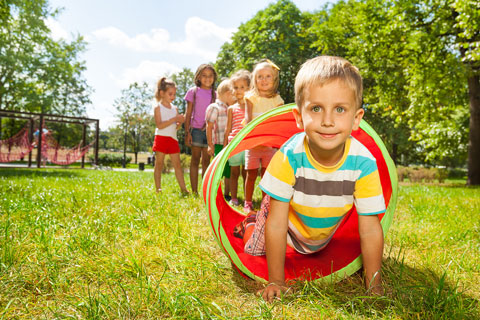Building endurance (increasing the length of time that one can continue a physical activity) is a central part of physical fitness. Fitness is important for preschool children because health habits begin early and can influence later childhood and adult health. Teachers play an important role in supporting children’s physical activity.
Young children need to move!
Keep children active throughout the day by integrating movement into your lesson plans.If the children are reading a story about an animal, take time to stretch as tall as a giraffe or walk like an elephant or crab. Make a letter T by holding arms out straight. Count by jumping up and down five times. Start and end circle time with a dance.
Provide time for structured physical activity as well as time for self-directed play.
Plan for at least 30 minutes each day of structured activity that includes stretching, large muscle activities, and time to cool down. Make it fun by including games and dancing. Avoid competitive games that may discourage the inactive child.
Teach skills and attitudes that encourage healthy, active lives.
Teaching children to stretch, warm-up, and cool-down when exercising helps avoid injury. A child who learns basic movement skills, such as throwing and catching a ball, or jumping with both feet and landing safely, may be more confident in her ability to enjoy sports and games. Be aware of disabilities, developmental delays, and limitations and plan movement activities that can include everyone.
Teach fitness for children as an ongoing process.
Emphasize regular vigorous exercise and healthy lifestyles. Encourage children to set and meet their own exercise goals and not compare themselves to others. For example, “Caron, I noticed that you rode the tricycle around the play equipment three times today! I wonder if you could ride it around the equipment four times tomorrow.” Or, “Jimmy, great job balancing on one foot for 10 seconds. Can you try to do 12 seconds next time?”
Make an activity pyramid with your class.
Begin with a broad base of exercises that can be done everyday. Add a layer of the kinds of vigorous exercise and active play the children should enjoy several times a week. Top with activities to cut down on, such as watching television and playing video games.
Involve parents.
Many adults are interested in improving their own fitness and endurance levels. Encourage parents to walk and play actively with their children. Having a screen-free afternoon and going for a walk or dancing to music can be fun for everyone in the family.
IEL Resource
- Resource List: Preschoolers’ Fitness and Growth


 PDF
PDF